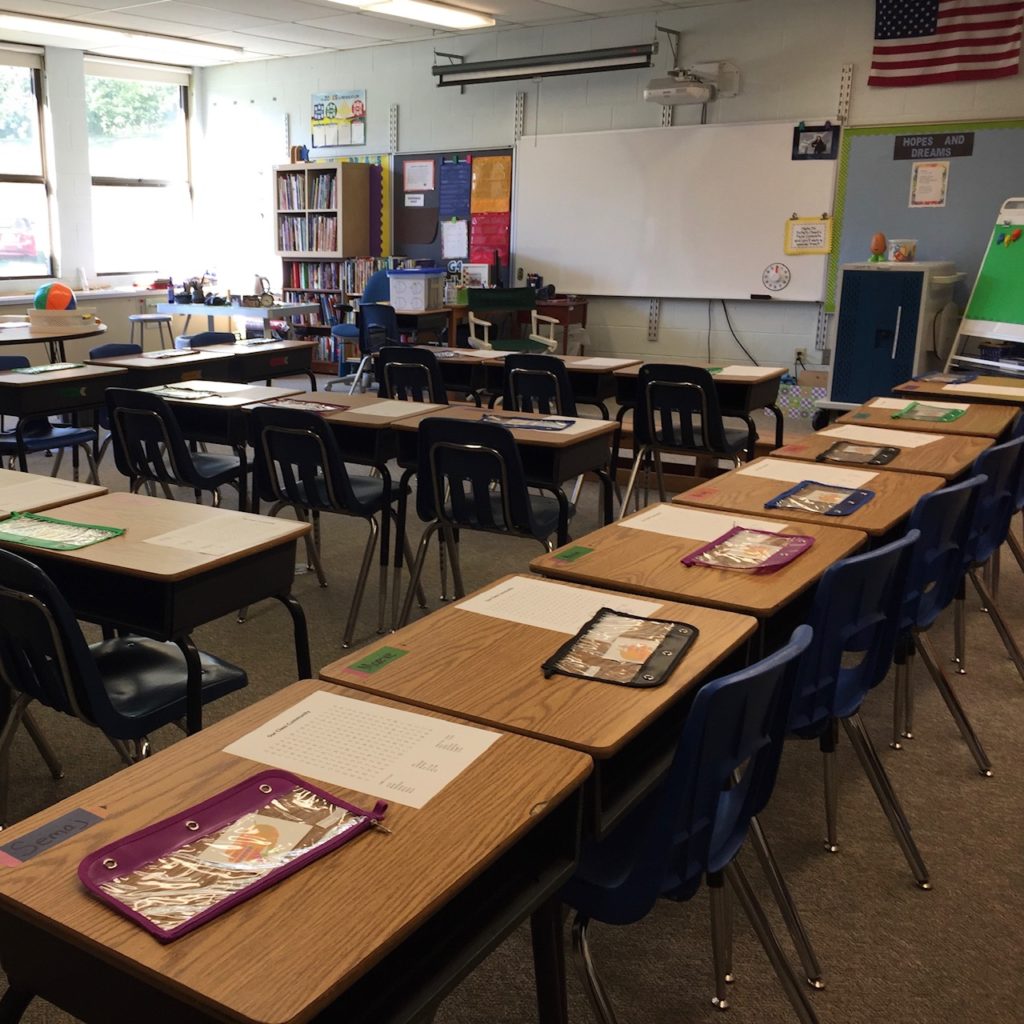THREE ELEMENTARY SCHOOLS NOT ENOUGH IN POST-PANDEMIC AMHERST

Empty classroom at Wildwood School. Photo: Toni Cunningham
“Wildwood won’t have 380 students in the fall in the building at the same time. Crocker Farm won’t have 400.” That was the hard truth shared by Superintendent Michael Morris to the Amherst School Committee this week.
While expressing a priority to get all elementary students into classrooms every day in the fall, Morris acknowledged that those students will not fit in the three elementary buildings under the current physical distancing guidelines issued by the CDC and Department of Elementary and Secondary Education (DESE). “We’re going to need space somewhere else,” he said. What that will mean in practice is yet to be determined.
Morris inferred that distance learning, while more adaptable for students in grades 7-12, is more difficult for elementary-aged children, especially those in the younger grades. The District undertook a survey in April to assess how Distance Learning 2.0 was working but the results have not been made publicly available. The inference was that if secondary-level students were not physically in the middle and high school and instead doing distance learning, it could open up the possibility of elementary students using those buildings.
In order to plan space for the fall, Morris proposed holding joint meetings of the Amherst, Pelham and Regional School Committees in June. Amherst’s elementary and secondary schools are not in the same school district, and while the Town owns the elementary schools, the middle and high school buildings are owned by the Region. This poses a unique fiscal challenge, according to Morris. If K-6 students were to use the middle or high school buildings, there would have to be some financial arrangement wherein the Town compensates the Region for this resource. Amherst accounts for approximately 80% of the regional district’s students, with Leverett, Pelham and Shutesbury combined making up the other 20%. Morris noted there could also be significant costs if the elementary district used sites outside of the schools, like mobile classrooms, for example.
In last week’s Superintendent’s update emailed to all families in the districts, Morris said ten groups made up of staff, teachers, paraeducators, and administrators will begin work on planning for the fall, assuming schools will reopen with students and staff physically in the buildings while also planning for the possibility of intermittent periods of distance learning. Morris’ comments at the School Committee meeting, however, indicated the focus will likely be on getting elementary students physically in buildings each day in the fall. Recent CDC guidelines would require far smaller class sizes/groupings than the current 16-23 students, plus protocols to minimize casual interactions, like passing in the halls. “Duration (of interaction) seems to be a really important variable in virus transmission,” he said.
Committee member Kerry Spitzer asked Morris about the intersection of School Choice and reduced class size, referring to the CDC guidance (pages 45-48) on restricting physical contact to the local geographic area only. The Committee had recently voted to remain a School Choice district in the fall but Spitzer wondered if limiting the number of slots would be advisable. Morris responded that “School Choice students are our students,” and that he interpreted the CDC guidance as referring more to students from multiple states attending sleep away camps than to students from neighboring towns attending local schools.
While DESE guidelines — most of which will be mandatory according to Morris — are not yet available, the CDC has provided extensive recommendations for schools. Indy research revealed the CDC’s “Considerations for Schools” emphasize not only the now-well-known hygiene behaviors (masks, hand washing, disinfecting, etc.), but also suggest that schools “ensure ventilation systems operate properly”, ”install physical barriers, such as sneeze guards and partitions”, “close communal-use shared spaces such as dining halls and playgrounds with shared playground equipment,” and conduct daily health checks of staff and students.
Morris expects some families will choose not to come back to school in the fall, at least at the beginning, and said that it is very difficult to predict at this point what the enrollment numbers will be. Similarly, he acknowledged it is likely that some staff will choose to stay home. The Indy emailed the District to ask whether they plan to re-send the form to families that asks about their school plans for the fall but didn’t receive a response by press time.
The FY21 operating budget that was presented at the meeting included no additional funding for staffing, although Finance Director Doug Slaughter acknowledged the staffing needs likely will not fit within the current budget. Committee member Peter Demling added, “it’s quite possible that at some point over the course of FY21, we’re going to have to come back to the Town Council for an increase in operating or capital budget because of COVID…What we’re hearing from DESE and the CDC is starting to paint this picture of a lot of resources needed.”

A question: If UMass or Amherst College are not fully in person in the fall, might they have space to donate to the schools? Pelham has no cafeteria, lunches are delivered there, so while this kind of idea would require a bit more infrastructure, it could give the school system space.
Laura, there was no mention explicitly of using the university campuses but I assume everything will be considered. There could be an expense to using university or college space, and there would certainly be additional transportation costs. I would imagine the districts would prefer to use ARPS school space first and then see what the needs are beyond that. It’s all up in the air right now.